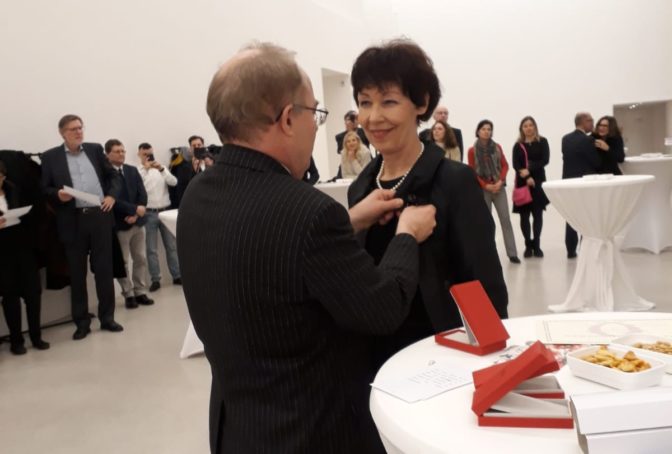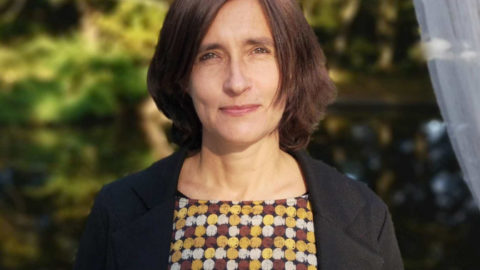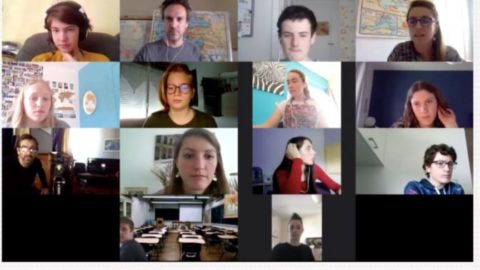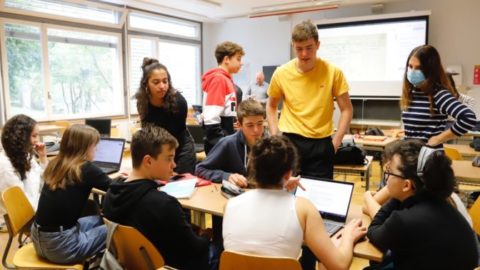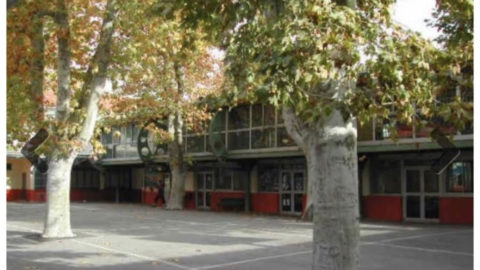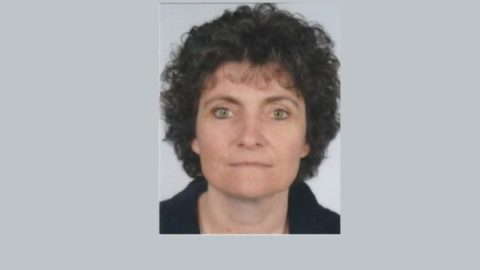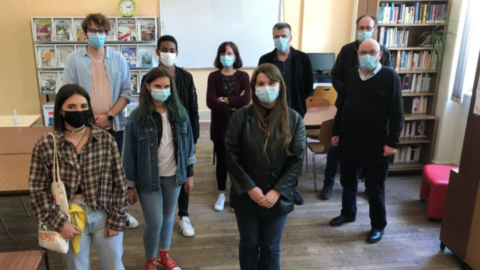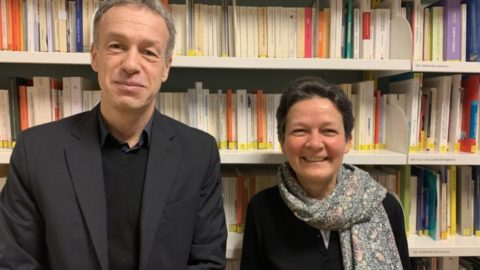During the 2017-2018 school year, Friederike Scharf and seven students from a 11th grade class at the Akademisches Gymnasium high school in Vienna, Austria, worked on the biography of Gerard Klebinder, a Convoy 77 survivor. This was one of eleven European projects chosen by the French Ministry of Education.
Please could you tell us about yourself and your class?
I am 67 years old and I carried out this project a year before I retired. At the Akademisches Gymnasium school in Vienna, I taught French and History. This helped me a lot. I was always very interested in Austrian history from 1914 to 1955, especially the discrimination and persecution of the Jewish population in our country. In 2012, I participated in a training seminar for Austrian teachers at Yad Vashem: “How to Teach the Holocaust.” During this course, I realized that students can only truly understand and empathize with the plight of the Jews if they take an active interest in the life of one person, or a whole family, who was persecuted. When I was told about the Convoy 77 project in February 2018, I saw it as a good opportunity to involve my students.
That school year, I ran an extra, optional history course for senior students. Twelve students, from three different classes and all aged 16 to 17, volunteered. I was fortunate enough therefore to be working only with students who were actively interested in history. In this optional class, the students were able to work on themes that they chose collectively as they wished to explore them further. When I proposed the Convoy 77 project to them, they decided, after a short discussion, that they would like to take part in it.
How did you organize this group work in the context of the Convoy 77 project?
This was a task that kept us busy throughout the second semester.
Initially, the students worked in pairs. They searched the Internet for information on the following topics:
– The conditions in the camps and prisons in which Gerard Klebinder was held (Montluc, Drancy, Auschwitz, Mauthausen, Ebensee)
France and its complicity in the Holocaust – Lyon 1940-44 (the Vichy regime, Klaus Barbie, his trial, the children’s home at Izieu)
– Anti-Semitism in the Vienne department in the inter-war period.
– What happened to the Jews after 1945. They spent eight two-hour periods on this.
After that, the results of the research were submitted to me and were collated in a booklet that was distributed to all of the students. Those who specialized in each of the various themes then presented their work to the group.
During the four months of work, the students had to keep a type of journal, in which they made a plan to help organize their work, which had to be updated regularly, and in which they also expressed their thoughts and feelings.
The second stage I undertook myself, because I was working with students who did not speak French or whose level of French was such that it would have been very difficult for them to translate the French documents that had been sent to me. I therefore gave them a sheet on which the different stages of Gerard Klebinder’s life were clearly listed and beside these I made notes about what we still needed to find out.
The research work was then carried out by the students. I gave them contacts from whom they could find out more about Gerard Klebinder’s life, either by e-mail or in person. In pairs or threes, they contacted the Vienna Jewish Community Archive, the Wiesenthal Center, the National Archives, and the Vienna City and State Archives (WStLA). During this time, we did not see each other in person; the groups worked for a month from their homes or in the Archives centers.
At the beginning of May, I received the written results of their research. I then wrote a sheet containing all the information about Gerard Klebinder’s biography, on which the new biographical data were included. The students were briefed about the new findings during short presentations.
Then came the final phase: I gave the students a sheet of paper on which Klebinder’s biographical data were cross referenced with the historical events of the time. In pairs, the students chose the chapter they wanted to work on. They had to address the bigger picture via the smaller ones. This was the most difficult part, as the students found it very hard to merge their vast knowledge of historical events with the biographical information in a way would make the biography stand out.
When they gave me the copies, I had to edit a few passages. Ultimately, all students received a printed version of the biography.
What impact has this work had, from an individual point of view (on you personally and on the students) and also more broadly (on the school, the municipality and others)?
As far as I am concerned, on the one hand, this project involved many hours of work (translation of the French documents, writing of the worksheets, reading and correction of the papers and comments on the journals). On the other hand, I was delighted with the project because the students learned a lot and were very interested in what happened to Gérard Klebinder.
They showed great interest in the topics covered. Not only did they gather new information about the period they were working on, but they also learned to work in a team, to respect the formal and organizational requirements of a “scientific” assignment, and they also got emotionally involved by recording their feelings and impressions during the project. I am confident that the majority of students will never forget what they learned about Gérard Klebinder’s life.
However, this work also had a broader impact. During the last week of school, the students visited the Ebensee concentration camp, the last stage of Gérard Klebinder’s deportation. Whilst there, they were congratulated on their work by the local archivist. The commendations were then published in the memorial magazine.
Your work was chosen as one of the most noteworthy projects. How do you and/or the students feel about that?
This tribute to the memorial work carried out by my students was, for me, the reward for all the work that I personally put in to support my students to the best of my ability. And of course, we were very proud when we heard that our project had been chosen, together with nine others, from more than 300 biographies submitted.
What advice would you give to other teachers who would like to participate in the project?
I would recommend that they take part in this project, as I did, as an optional history course, because then it does not have to tie in with the school curriculum. Through the project, the students would not only have the opportunity to study the Holocaust in depth, but also, with appropriate guidance from the teacher, would be well prepared to write a scientific dissertation as is required in their final year of high school.
It is also possible to work across disciplines. In French classes (level B1 or B2), the French documents could be translated and a first draft of a biography could be written, while in History classes, information could be gathered about the situation in Austria.


 Français
Français Polski
Polski